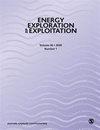A spatial ranking of optimal sites for solar-driven green hydrogen production using GIS and multi-criteria decision-making approach: A case of Tunisia
IF 1.6
4区 工程技术
Q4 ENERGY & FUELS
引用次数: 0
Abstract
The unpredictable nature of renewable energy sources, such as solar and wind, raises concerns about consistent power supply based on a single type. Green hydrogen presents a promising solution to mitigate the environmental effects of fossil fuels and control the unpredictability of renewable energy sources. Yet, developing green hydrogen systems mandates immense financial commitments, vitally stressing the importance of determining the most appropriate locations before constructing them. As such, the primary purpose of this paper was to propose an initial spatial analysis and prioritize the most suitable locations for installing solar-based green hydrogen systems in Tunisia. For this reason, an exhaustive literature survey was conducted to develop a GIS-based MCDM approach, taking into account technical, topography, environmental, and accessibility criteria. Then, EDAS, ARAS, MOORA, and COPRAS techniques were used to rank the most promising sites resulting from the previous stage. The study revealed that sites of high suitability, primarily in the southeastern and southwestern parts of Tunisia, spanned a total area of 1591 km利用地理信息系统和多标准决策方法对太阳能驱动的绿色制氢的最佳地点进行空间排序:突尼斯案例
太阳能和风能等可再生能源的不可预测性引发了人们对基于单一类型的稳定电力供应的担忧。绿色氢能为减轻化石燃料对环境的影响和控制可再生能源的不可预测性提供了一个前景广阔的解决方案。然而,开发绿色氢能系统需要巨大的资金投入,这就强调了在建造之前确定最合适地点的重要性。因此,本文的主要目的是提出初步的空间分析,并优先考虑最适合在突尼斯安装太阳能绿色制氢系统的地点。为此,我们进行了详尽的文献调查,在考虑技术、地形、环境和可达性标准的基础上,开发了基于 GIS 的 MCDM 方法。然后,使用 EDAS、ARAS、MOORA 和 COPRAS 技术对前一阶段得出的最有前景的地点进行排序。研究结果表明,适宜性较高的地点主要位于突尼斯的东南部和西南部,总面积达 1591 平方公里(0.78%)。在这些地区中,斯法克斯、莫纳斯提尔和苏塞似乎是最适合太阳能制氢的地区。最适合 "发展太阳能制氢的地区的潜在制氢能力为每年 9.91 亿吨,其中斯法克斯、莫纳斯提尔和苏塞占 14.5%。通过挖掘这一巨大潜力并拥抱绿色氢能产业,突尼斯有机会在可再生能源的采用方面处于领先地位。此举有助于确保能源安全,减少对进口的依赖,刺激经济增长,引导国家走向更加可持续和繁荣的未来。
本文章由计算机程序翻译,如有差异,请以英文原文为准。
求助全文
约1分钟内获得全文
求助全文
来源期刊

Energy Exploration & Exploitation
工程技术-能源与燃料
CiteScore
5.40
自引率
3.70%
发文量
78
审稿时长
3.9 months
期刊介绍:
Energy Exploration & Exploitation is a peer-reviewed, open access journal that provides up-to-date, informative reviews and original articles on important issues in the exploration, exploitation, use and economics of the world’s energy resources.
 求助内容:
求助内容: 应助结果提醒方式:
应助结果提醒方式:


